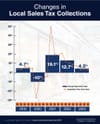State Comptroller: Local Sales Taxes Grew 4.2% in NY State to $23 Billion in 2023
New York City’s sales tax growth of 5.9% in 2023 exceeded the aggregate results for the counties and cities in the rest of the state (2.4%).

ALBANY—Local government sales tax collections in New York State, fueled by growth in New York City sales taxes, totaled $23 billion in calendar year 2023, up 4.2%, or $919 million, from 2022, according to a report released today (Feb. 5) by New York State Comptroller Thomas P. DiNapoli.
“Growth in local sales tax collections statewide moderated in 2023, following two years of double-digit increases,” DiNapoli said. “The fluctuations in sales tax collections that characterized the pandemic period have subsided. Local officials should plan for sales tax revenue with more stable and modest growth rates.”
Local sales tax collections in the fourth quarter of 2023 increased by 3.1% compared to the same quarter of 2022, similar to the 3% and 3.6% year-over-year growth experienced in the second and third quarters, respectively, and not nearly as robust as the 7.1% growth in the first quarter.
New York City’s sales tax growth of 5.9% in 2023 exceeded the aggregate results for the counties and cities in the rest of the state (2.4%). Growth in the city’s collections, which typically account for approximately two-fifths of the statewide total, was boosted by increases in domestic and international tourism, which approached pre-pandemic levels this past holiday season.
County collections, in total, grew by 2.4%, or $259 million, in 2023 compared to the previous year. Most (50 of 57) counties outside of New York City experienced a year-over-year increase in sales tax collections, with many smaller counties seeing the strongest growth.
Sullivan County had the largest increase at 11.6%, followed by the counties of Schoharie (10.9%), Chenango (7.9%) and Schuyler (7.8%).
Yates County experienced the steepest decline in collections (-5.6%), followed by the counties of Cayuga (-2.5%), Steuben (-1.5%) and Rockland (-1.4%).
Of the 18 cities outside of New York City that impose their own sales tax, 15 saw year-over-year increases in 2023. Oswego had the strongest growth at 16%, followed by Glens Falls (9.6%), Norwich, and Oneida (8.9% each). Three cities experienced modest decreases in collections, with Auburn and Ithaca seeing a decline of 0.2% each, followed by Yonkers at less than 0.1%.



